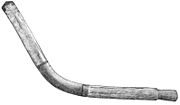Rabbit stick
| Rabbit stick | |
|---|---|

|
|
| Information | |
| Weapon type: | Throwing wood, boomerang |
| Designations: | Patshkohu, rabbit sticks, Kleane |
| Use: | weapon |
| Region of origin / author: |
North America , Hopi Indian and Zuñi ethnic groups |
| Distribution: | North America |
| Overall length: | about 61 cm |
| Blade width: | about 4 cm |
| Blade thickness: | about 1.90 cm |
| Handle: | Wood, natural colors, natural resin |
| Lists on the subject | |
The Rabbit Stick ( German Hasenstock ; plural: Rabbit Sticks, also in the spelling Rabbit-sticks) is a curved throwing stick from North America.
Designations
The Hopi call it Patshkohu (also: Putskohu ), the Zuñi Macana or Kleane ( kle-an-ne ).
description
The Rabbit Sticks are made from the wood of the Gambel oak (Quercus gambelii Nutt.). They are made flat and slightly curved. The front end is usually cut straight or rounded. At the other end a kind of handle is worked out. The surface is smoothed with the help of natural resin , the edges are sharp. You will be thrown inside out at the target.
They are often painted in red, black and green for decoration. There are different versions that differ in length and shape. The Rabbit sticks are used by the Hopi ethnic group as a hunting weapon , sports equipment and as a ceremonial weapon in the "Tata Huila" dance.
During the hunt, they were used on foot or on horseback. The successful hunt for hares was an important cultural act. The successful hunters enjoyed a high status in society. The Chumash , Navajo , Gabrieleno and Zuñi ethnic groups also used similar throwing woods.
The Kylie is known from Australia and was used by the indigenous peoples for various purposes, similar to the rabbit stick.
literature
- Hans Dietschy : The American clubs and wooden swords in their relationship to the cultural history of the New World. Dissertation. Brill, Leiden 1939, p. 134 and Fig. 14a.
- Robert F. Heizer: Ancient grooved clubs and modern rabbit-sticks. In: American antiquity. Society for American Archeology . Volume 8, No. 1, 1942, pp. 41-56. ( JSTOR stable url ).
- Ruth Murray Underhill: Work a day life of the Pueblos. (= Indian life and customs. 4). US Indian Service, Washington, DC [1946], pp. 68-69. (Reprinted from AMS Press, New York 1983, ISBN 0-404-15735-1 ).
- Travis Hudson, Thomas C. Blackburn: The Material Culture of the Chumash Interaction Sphere. Volume 1: Food procurement and transportation. (= Ballena Press anthropological papers. 25). Ballena Press, Los Altos, Calif. 1982, ISBN 0-87919-099-X , p. 134.
- Monte Burch: Making Native American Hunting, Fighting, and Survival Tools. The Complete Guide to Making and Using Traditional Tools. Lyons Press, Guilford, CT 2004, ISBN 1-59228-020-X , pp. 210-211. ( limited preview in Google Book search).
Web links
- Rabbit sticks at Texas Beyond History
- Rabbit sticks in the Anasazi Heritage Center, Colorado, USA ( Memento from January 24, 2013 in the web archive archive.today )
Individual evidence
- ↑ Hans Dietschy: The American clubs and wooden swords in their relationship to the cultural history of the New World. Dissertation. Brill, Leiden 1939, p. 134
- ↑ George Cameron Stone : A Glossary of the Construction, Decoration and Use of Arms and Armor: in All Countries and in All Times. 1934. Reprint. Dover Publications, Mineola, New York 1999, ISBN 978-0-486-40726-5 , pp. 522-523
- ↑ Example Rabbit Stick at Pitt Rivers Museum, Oxford, inventory no. 1903.36.41 , English, accessed September 26, 2012.